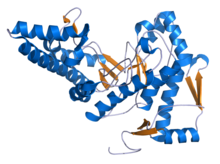Vitrase
Hyaluronidases are a family of enzymes that catalyse the degradation of hyaluronic acid (HA). Karl Meyer classified these enzymes in 1971 into three distinct groups, a scheme based on the enzyme reaction products. The three main types of hyaluronidases are two classes of eukaryotic endoglycosidase hydrolases and a prokaryotic lyase-type of glycosidase.
In humans, there are five functional hyaluronidases: HYAL1, HYAL2, HYAL3, HYAL4 and HYAL5 (also known as SPAM1 or PH-20); plus a pseudogene, HYAL6 (also known as HYALP1). The genes for HYAL1-3 are clustered in chromosome 3, while HYAL4-6 are clustered in chromosome 7. HYAL1 and HYAL2 are the major hyaluronidases in most tissues. GPI-anchored HYAL2 is responsible for cleaving high-molecular weight HA, which is mostly bound to the CD44 receptor. The resulting HA fragments of variable size are then further hydrolized by HYAL1 after being internalized into endo-lysosomes; this generates HA oligosaccharides.
According to their enzymatic mechanism, hyaluronidases are hyaluronoglucosidases (EC 3.2.1.35), i.e. they cleave the (1->4)-linkages between N-acetylglucosamine and glucuronate. The term hyaluronidase may also refer to hyaluronoglucuronidases (EC 3.2.1.36), which cleave (1->3)-linkages. In addition, bacterial hyaluronate lyases (EC 4.2.2.1) may also be referred to as hyaluronidases, although this is uncommon.
...
Wikipedia

